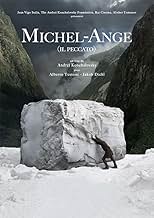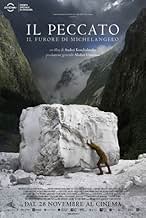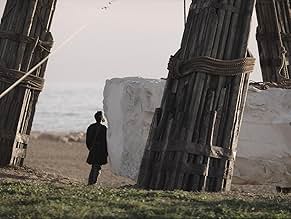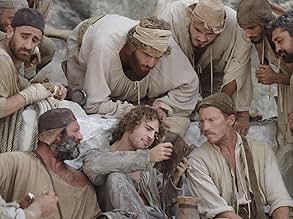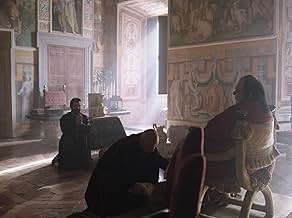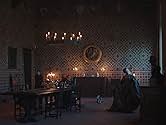IMDb-BEWERTUNG
6,8/10
1458
IHRE BEWERTUNG
Das Leben von Michelangelo Buonarroti.Das Leben von Michelangelo Buonarroti.Das Leben von Michelangelo Buonarroti.
- Regie
- Drehbuch
- Hauptbesetzung
- Auszeichnungen
- 3 Gewinne & 2 Nominierungen insgesamt
Empfohlene Bewertungen
Up until the final scene, Il Peccato seems a beautiful chaos, with an apparently random series of scenes that seem to go nowhere in particular. But, alas, the finale might be enlightening.
Konchalovsky's film obviously echoes Andrei Rublev, even though it can't be but a shadow if compared to Tarkovsky's masterwork, by portraying Michelangelo as a troubled artist that feels out of place in his brutal times. Unlike Rublev, Michelangelo is however torn by less religious themes, even though he too complains about the brutality of his commissioners, the Della Rovere and the Medici families. Always in economic difficulties, always aspiring to a sublime that he identifies in poet Dante Alighieri, never able to settle in one place, fueled by an inner omnipresent rage. Ultimately, Michelangelo's titular 'sin' is not revealed, but it might be pride: he makes no secret of how he considers himself to be a genius far above anyone else, he tries to do overly impossible things without accomplishing them entirely. A physical representation of his pride might constitute the huge marble block seen in the poster, that pays a specific role in part of the film.
The cast is made up of less well-known italian actors, but Alberto Testa in particular seems the perfect choice in terms of appearance to play the Renaissance Sculptor. Equally particular is the choice to shoot the movie in 4:3 aspect ratio. The coloring however somehow reminded of Sokurov's Faust.
Nice work with beautiful scenes recreating the atmosphere of those times perfectly well.
Michaelangelo was a genius sculptor and each of his creations move the soul even of modern people, lots of whom have hardly any taste of art at all. This film is artistic enough, beautiful and talented, made by a very professional director of soviet school. Just the right background to tell a story of a genius.
No soundtrack can also mean no noise pollution. I enjoyed everything about this movie
Watching this film you might wonder "What on Earth this has to do with Michelangelo, except for the decorations?"
While it is a good idea to try a character and period study, rather than a glamorous Hollywood-style biopic, this film is a blank shot at it. On the one hand the cast is interesting, the non-professional actors play well (though such cast would fit better Boccaccio's "Decameron"). The film overall slightly reminds films by Fellini or Milos Forman's "Amadeus" - where there are many grotesque moments, the main character could be almost a caricature but Forman unlike Konchalovsky manages very well the contrast between comical and tragic. In the "Sin" the grotesque is purposeless, because the script is very weak, the storytelling is not engaging and the main character never steps out from the void of half-craziness. In Forman's film Mozart could look dumb, but as soon as music started he turned into a genius. Konchalovsky's Michelangelo only counts coins, argues contracts and purchases marble. He never touches a chisel or brush, he is never shown as a thinker or a poet. There is no moment to sympathize with him or understand why such person could create great art. It is an empty caricature rather than a human.
To sum up, this film is an unfortunately waste of promising actors and excellent Tuscan scenery. Some snapshots are well done because the cast and the decorations are good. But overall you will not gain much by watching this half-baked production, unless you are interested in evolution of Konchalovsky as a director.
While it is a good idea to try a character and period study, rather than a glamorous Hollywood-style biopic, this film is a blank shot at it. On the one hand the cast is interesting, the non-professional actors play well (though such cast would fit better Boccaccio's "Decameron"). The film overall slightly reminds films by Fellini or Milos Forman's "Amadeus" - where there are many grotesque moments, the main character could be almost a caricature but Forman unlike Konchalovsky manages very well the contrast between comical and tragic. In the "Sin" the grotesque is purposeless, because the script is very weak, the storytelling is not engaging and the main character never steps out from the void of half-craziness. In Forman's film Mozart could look dumb, but as soon as music started he turned into a genius. Konchalovsky's Michelangelo only counts coins, argues contracts and purchases marble. He never touches a chisel or brush, he is never shown as a thinker or a poet. There is no moment to sympathize with him or understand why such person could create great art. It is an empty caricature rather than a human.
To sum up, this film is an unfortunately waste of promising actors and excellent Tuscan scenery. Some snapshots are well done because the cast and the decorations are good. But overall you will not gain much by watching this half-baked production, unless you are interested in evolution of Konchalovsky as a director.
The main thing I would like to point out is that every single scene from this movie was like a beautiful painting straight out of an Italian museum. I can't remember when was the last time the visuals of a movie stunned me so greatly that I was with each scene change surprised by the beauty of the images.
Secondly, the feeling I get reading the rest of the reviews, and hearing other people comment on the movie, is that that people almost expect this movie to be a some sort of thriller depicting the genius of Michelangelo, the person we all know as the one of the worlds greatest artists of all time. But the greatness of this movie is in the contrary - Michelangelo is portrayed as a mere, sinning human - who steals, betrays, lies, and also hates showering. He is a imperfect person just like any other, haunted by his fears and suspicions and I can't shake off the feeling that people did not (or did not want) to see Michelangelo in those lens. But for me that is the main thing that makes this movie so great - the viewer can share Michelangelos' emotions and thoughts as if they were their own or of their friend, since the artists is another common, but very talanted man, and not some untouchably skilled alien of the past.
Thirdly, the movie shows us only a fragment of the artists life, and a fragment describing the very beginning of the sculpting process, and it is that time that the fullness of Michelangelos' character can be met, like it is in the movie. Who wants to see a historical documentary about his whole life? You can tune into the History channel if your into that. On the other side, the movie is an artistic take at an artists life, excellently describing Michelangelos true identity, his problems and thoughts, related or not to his work.
For me, the point and the idea of the movie is that Michelangelos works such as David and Pieta were not thought up in the vast and luxuriose castles and churches of Florence, while the artists was enjoying a cup of tea snf reading philospophy, but instead, in the middle of a marble mine in high up in the mountains, alongside plain working men, when the idea arises in sight of a mere daughter of one of the workers leans on a marble rock for a short afternoon sleep - it is that plain scene which inspires the divine masterpiece of the artists work today. This is what makes the movie so down to earth and realistic, and in combination with the incredible scenery, makes the viewer feel like he is in 16th century Italy for two hours.
Secondly, the feeling I get reading the rest of the reviews, and hearing other people comment on the movie, is that that people almost expect this movie to be a some sort of thriller depicting the genius of Michelangelo, the person we all know as the one of the worlds greatest artists of all time. But the greatness of this movie is in the contrary - Michelangelo is portrayed as a mere, sinning human - who steals, betrays, lies, and also hates showering. He is a imperfect person just like any other, haunted by his fears and suspicions and I can't shake off the feeling that people did not (or did not want) to see Michelangelo in those lens. But for me that is the main thing that makes this movie so great - the viewer can share Michelangelos' emotions and thoughts as if they were their own or of their friend, since the artists is another common, but very talanted man, and not some untouchably skilled alien of the past.
Thirdly, the movie shows us only a fragment of the artists life, and a fragment describing the very beginning of the sculpting process, and it is that time that the fullness of Michelangelos' character can be met, like it is in the movie. Who wants to see a historical documentary about his whole life? You can tune into the History channel if your into that. On the other side, the movie is an artistic take at an artists life, excellently describing Michelangelos true identity, his problems and thoughts, related or not to his work.
For me, the point and the idea of the movie is that Michelangelos works such as David and Pieta were not thought up in the vast and luxuriose castles and churches of Florence, while the artists was enjoying a cup of tea snf reading philospophy, but instead, in the middle of a marble mine in high up in the mountains, alongside plain working men, when the idea arises in sight of a mere daughter of one of the workers leans on a marble rock for a short afternoon sleep - it is that plain scene which inspires the divine masterpiece of the artists work today. This is what makes the movie so down to earth and realistic, and in combination with the incredible scenery, makes the viewer feel like he is in 16th century Italy for two hours.
A nice but slowly paced biopic about life of Michelangelo Buonarroti . It is a gripping but dull reflection on the agony and ecstasy of his individual greatness as well as his misfortunes and privations . Set in Florence, early XVI century , the picture deals with Michelangelo or Michael Angel who is working on the Carrara's marble creating sculptures and he is then ordered by Pope Julius II to build his tomb and while painting of as called Sistine chapel (that's why it was built by Pope Sisto) . Although widely considered a genius by his contemporaries, Michelangelo Buonarroti (Alberto Testone giving a first-range acting) he suffers poverty , starvation , deceits and shortages . Depicting the profound humanity behind the legend of the Renaissance . Meanwhile , he'll develop various relationships with other Renaissance's important people . The film is correctly based on historical deeds and appearing famous roles , such as : Raphael , Papa Giulio II, Papa Leon X , Dante Alighieri , Giulio De' Medici , Lorenzo Medici , Boccaccio and Marchese Malaspina . The motion picture describes specially the creation of the enormous paintings on the ceiling and the difficulties that Michael Angel is suffering to achieve the immortal legacy . The Pope Julius II will also assign him the realization of his tomb , but then his commissioner and head of the Della Rovere nobility Pope Julius II dies , Michelangelo becomes obsessed with sourcing the finest marble to complete his tomb. The artist's loyalty is tested when Leo X , of the rival Medici family, ascends to the papacy and charges him with a lucrative new commission - the façade of the San Lorenzo basilica . Forced to lie to maintain favour with both families , Michelangelo is progressively tormented by suspicion , betrayal and hallucinations , leading him to ruthlessly examine his own moral and artistic failings.
In Il Pecccato or The Sin whe find us an outandish Michelangelo as a lonely sculptor who's reduced to poverty and depleted by his struggle to finish the ceiling of the Sistine Chapel and an unfinished tomb of Julius II . Throughout the film we witness the confrontation of the two families that dominated sixteenth century Florence: the Della Rove and the Medici. At the same time we observe the hard work of Michelangelo as he tries to extract the marble from Carrara and as he sculpts the famous sculptures of Moses and the Pietà. The feature movie obtained a limited success and had a moderated box-office ; however , being nowadays better valued than when its premiere . The movie follows the Pasolinian wake more than the Carol Reed's The Agony and the Ecstasy (1965) style ; but I really prefer the classic and spectacular film with Charlton Heston and Rex Harrison (both of whom were magnificent) than this slow-moving , sad and poor version about this immortal historical character.
The motion picture was well written and directed by Andrei Konchalovsky. His first big hit was Siberiada (1979) - a dramatic and realistic story of the lives of the people of Siberia - was internationally acclaimed and brought Konchalovsky to the attention of American and European producers. From then on-wards his career has been international in scope. Pleasing critics and audiences worldwide, he made the English language films Maria's lovers (1984), Runaway train (1985), Duel for one (1986) with praised for Max von Sydow's brilliant performance), and the award-winning Homer y Eddie (1989) starring Whoopi Goldberg. Konchalovsky moved to the mainstream territory with the action packed Tango y Cash (1989). And other excursions to Hollywood to make mainstream TV productions like the Emmy-winning The Odyssey (1997) and Lion in Winter (2003) with Glenn Close , and several others. Rating Sin : 6/10 . Passable and acceptable.
In Il Pecccato or The Sin whe find us an outandish Michelangelo as a lonely sculptor who's reduced to poverty and depleted by his struggle to finish the ceiling of the Sistine Chapel and an unfinished tomb of Julius II . Throughout the film we witness the confrontation of the two families that dominated sixteenth century Florence: the Della Rove and the Medici. At the same time we observe the hard work of Michelangelo as he tries to extract the marble from Carrara and as he sculpts the famous sculptures of Moses and the Pietà. The feature movie obtained a limited success and had a moderated box-office ; however , being nowadays better valued than when its premiere . The movie follows the Pasolinian wake more than the Carol Reed's The Agony and the Ecstasy (1965) style ; but I really prefer the classic and spectacular film with Charlton Heston and Rex Harrison (both of whom were magnificent) than this slow-moving , sad and poor version about this immortal historical character.
The motion picture was well written and directed by Andrei Konchalovsky. His first big hit was Siberiada (1979) - a dramatic and realistic story of the lives of the people of Siberia - was internationally acclaimed and brought Konchalovsky to the attention of American and European producers. From then on-wards his career has been international in scope. Pleasing critics and audiences worldwide, he made the English language films Maria's lovers (1984), Runaway train (1985), Duel for one (1986) with praised for Max von Sydow's brilliant performance), and the award-winning Homer y Eddie (1989) starring Whoopi Goldberg. Konchalovsky moved to the mainstream territory with the action packed Tango y Cash (1989). And other excursions to Hollywood to make mainstream TV productions like the Emmy-winning The Odyssey (1997) and Lion in Winter (2003) with Glenn Close , and several others. Rating Sin : 6/10 . Passable and acceptable.
Wusstest du schon
- WissenswertesShot entirely in Italy. The movie was shot in Rome and its environs and in Tuscany, including at the Carrara quarry where Michelangelo got his marble.
- Zitate
Michelangelo Buonarroti: Money always rubs elbows with infamy.
- VerbindungenReferenced in Vecherniy Urgant: Andrei Konchalovsky/Pompeya (2019)
Top-Auswahl
Melde dich zum Bewerten an und greife auf die Watchlist für personalisierte Empfehlungen zu.
- How long is Sin?Powered by Alexa
Details
Box Office
- Budget
- 15.000.000 € (geschätzt)
- Weltweiter Bruttoertrag
- 243.043 $
- Laufzeit2 Stunden 14 Minuten
- Farbe
- Seitenverhältnis
- 1.33 : 1
Zu dieser Seite beitragen
Bearbeitung vorschlagen oder fehlenden Inhalt hinzufügen


![Trailer [OV] ansehen](https://m.media-amazon.com/images/M/MV5BYThkZDVkMGQtNGZiYS00NzMwLWFkOWUtYTFhYThiN2E4MTQwXkEyXkFqcGdeQXRyYW5zY29kZS13b3JrZmxvdw@@._V1_QL75_UX500_CR0)
